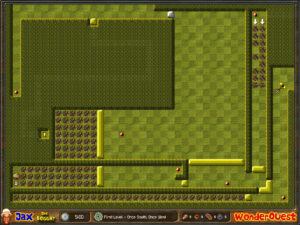Wonderquest: Monster Inventory
I still don’t have any idea why Wonderquest‘s main hold is titled “Master Orion”, but level 14 surprised me by giving a possible explanation for the title “Wonderquest”: in a sequence of texts, the party finds a newly-hatched floating eye monster and adopts it as a pet, naming it Steve Wonder due to its severe myopia. You might think that a creature made entirely of eye should be able to see really well, but in fact all the Eyes in this game have a kind of tunnel vision, remaining dormant until you enter their direct line of sight. If they’re facing diagonally, you can skip right through their line of sight by exploiting the grid. In other words, they’re exactly like the Evil Eyes in DROD.
Let’s take that as a cue to compare the Wonderquest monster roster with that of DROD more fully. Roaches are simply roaches, although the roach queen spawn cycle is 24 turns to match the 24-hour clock, instead of the DROD-standard 30. Mimics are present, although they’re called Elementals, and come in two flavors: fire elementals that copy your movements directly and water elementals that do the exact reverse. There are puzzles where you use a fire-water pair to execute something symmetric, like simultaneously hitting orbs in opposite corners, and there are puzzles that could have perfectly well given you control of a fire elemental but use a water elemental just to make things slightly more difficult. (In one case, it actually gives you a choice, framing it as the easy way vs the hard way and asking “What kind of person are you?” — which was enough to goad me into picking the hard way, even though it’s not really significantly harder in practice.
There’s a sort of creature called a “Fluffy” that’s basically like DROD‘s Wubbas (indestructible and non-deadly but in your way a lot), except willing to slide along obstacles laterally. There’s also an aggressive variant called a “Mad Fluffy”, which, strangely enough, is equivalent to DROD Goblins (avoids your weapon and tries to circle around behind you). This respeciation puzzled me until I found that Fluffies can be turned into Mad Fluffies by holding a lit torch on them for a number of turns. I haven’t yet seen a puzzle where this is something you’d want to do, but it can be done.
More interestingly, this idea of transforming monsters by affecting their mood is also applied to snakes. Snakes have three modes. In their neutral mode, they’re basically equivalent to DROD Serpents, except that they can go over water, creating a nice sea-serpent effect when you’re out on your boat. Get them angry by luring them into explosions, and they turn red, become smarter in their movement, and can go over lava and destroy force arrows. Lure them over food, and they become happy and green, and attempt to imitate your movements when possible. This last seems to be particularly useful in puzzle design, giving us something that’s like a mimic but more awkward, that can’t move diagonally and has to be kept out of the way of its own tail. The thing is, although all three types of snake are used a lot on the level that introduces them (level 13), the transformation capability is hardly used at all. Usually they spend an entire puzzle in one mood.
There are many DROD monsters that have no Wonderquest equivalent so far: Wraithwings, Living Tar, Stone Giants. The only Wonderquest monster without a DROD equivalent is the Butterfly, which moves like a chess knight, and is mainly used to spice up roach hordes a little.
 Comments(0)
Comments(0)